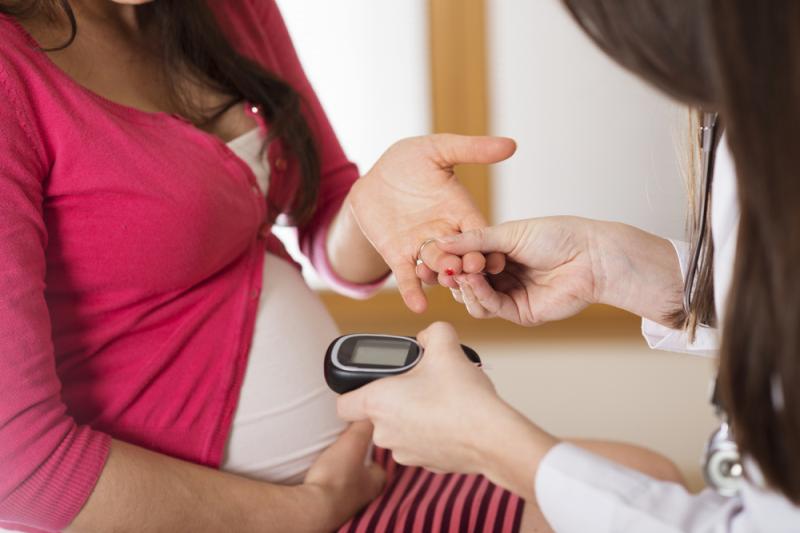
Maternal diabetes during pregnancy appears to increase the risk of early-onset cardiovascular disease (CVD) in offspring from childhood to early adulthood, according to a study.
“Our study provides evidence that children of mothers with diabetes, especially those with a history of CVD or with diabetic complications, had increased rates of early-onset CVD throughout the early decades of life,” the researchers said.
CVD was diagnosed in 1,153 offspring of mothers with diabetes and 91,311 offspring of mothers without diabetes during up to 40 years of follow-up. Children of diabetic mothers had a 29-percent higher overall rate of early-onset CVD (hazard ratio [HR], 1.29, 95 percent confidence interval [CI], 1.21–1.37). Among children unexposed to maternal diabetes, the cumulative incidence at age 40 years was 13.07 percent (95 percent CI, 12.92–13.21 percent; difference in cumulative incidence, 4.72 percent, 95 percent CI, 2.37–7.06 percent). [BMJ 2019;367:l6398]
Results of the sibship design were comparable to those of the unpaired design based on the whole cohort. Increased CVD rates in offspring were associated with both pregestational diabetes (HR, 1.34, 95 percent CI, 1.25–1.43) and gestational diabetes (HR, 1.19, 95 percent CI, 1.07–1.32). Moreover, there were varied increased rates of specific early-onset CVDs, particularly heart failure (HR, 1.45, 95 percent CI, 0.89–2.35), hypertensive disease (HR, 1.78, 95 percent CI, 1.50–2.11), deep vein thrombosis (HR, 1.82, 95 percent CI,1.38–2.41) and pulmonary embolism (HR, 1.91, 95 percent CI, 1.31–2.80).
Increased CVD rates were observed in different age groups from childhood to early adulthood until 40 years of age, and these were more noticeable among children of mothers with diabetic complications (HR, 1.60, 95 percent CI, 1.25–2.05). Furthermore, a higher incidence of early-onset CVD in offspring of mothers with diabetes and comorbid CVD (HR, 1.73, 95 percent CI, 1.36–2.20) correlated with the added influence of comorbid CVD but not due to the interaction between diabetes and CVD on the multiplicative scale (p-interaction=0.94).
“If maternal diabetes does have a causal association with increased CVD rate in offspring, the prevention, screening and treatment of diabetes in women of childbearing age could help to reduce the risk of CVD in the next generation,” the researchers said.
Previous studies have shown that offspring of diabetic mothers had a higher likelihood of exposure to several CV risk factors, including hypercholesterolaemia, hypertension, obesity, diabetes, chronic kidney disease and metabolic syndrome. [Diabetologia 2011;54:504-507; Circulation 2011;123:258-265; Int J Mol Sci 2018;19:E3665; BMJ Open 2019;9:e025084; J Clin Endocrinol Metab 2009;94:2464-2470; J Clin Endocrinol Metab 2015;100:986-993]
Genetic susceptibility, family environment variables or lifestyle characteristics could also contribute to the increased CVD risk in offspring born to diabetic mothers. [BMJ Open 2019;9:e025084]
“These findings highlight the importance of effective strategies for screening and preventing diabetes in women of childbearing age,” the researchers said. “We need to monitor CVD risks in offspring of mothers with diabetes and investigate possible life course interventions that could reduce the occurrence of CVD.”
The current population-based cohort study included all 2,432,000 liveborn children without congenital heart disease in Danish national health registries during 1977–2016. The researchers followed these children at birth until first time diagnosis of CVD, death, emigration or 31 December 2016, whichever came first.
Cox regression was used to determine whether a maternal history of CVD or maternal diabetic complications influenced the associations between maternal diabetes and risk of early-onset CVD in offspring. Adjustments were made for the following: sex, calendar year, singleton status, maternal factors and paternal history of CVD before childbirth.